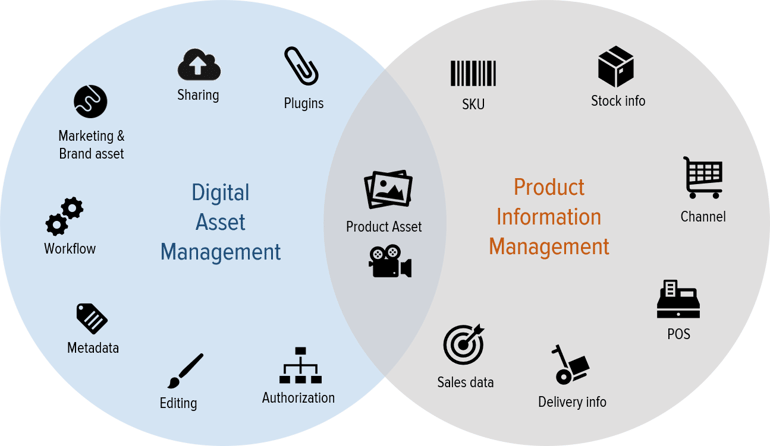What do you need to know about Product Information Management?
April 4, 2023 / 5 min read

Photo by Adrian Sulyok on Unsplash
Akaneo PIM, Sales Layer PIM, Salsify, inriver PIM, Pimcore and Plytix PIM - these are six of the most popular PIM tools out there.
What are their features? Which one should you choose? And what is PIM all about? That's what we want to discuss today.
What is Product Information Management (PIM)?
It is a system that helps organisations to manage and maintain accurate and consistent high-quality information about their products across all channels and departments. This can include information like product name, description, pricing, images, and more. PIM systems significantly improve product data management.
They can also help ensure customers have access to accurate and up-to-date product information across all channels. PIM creates a positive customer experience and is a foundation of an omnichannel commerce strategy.
What business problem does PIM solve?
PIM can solve several business problems, including:
- Data inconsistencies
PIM can help to ensure that product information is consistent across all channels and departments, reducing errors and inconsistencies that can lead to confusion and lost sales. - Data duplication
PIM can help to eliminate the need for manual data entry, reducing the risk of duplication and errors. - Lack of customer trust
PIM can help to increase customer trust by providing accurate and up-to-date omnichannel product information. It greatly reduces the risk of customer complaints and products return. - Lack of resiliency to market changes
PIM can help to increase agility in response to market changes by providing a central location for all product information that can be easily updated and distributed. - Lack of integration
Most PIM solutions have a vast number of 3rd party integrations for e-commerce, B2C and B2B solutions.
PIM features
A quality PIM solution should have the following features:
- Data import and export
PIM systems typically include tools for importing and exporting product data, making it easy to get data into and out of the system. - Data validation
PIM systems often include built-in validation rules to ensure that product data is accurate and complete. Helps to identify and fix problematic or inconsistent product data and metadata. - Data conversion
PIM systems typically include tools for mapping data from one format to another, making it easy to integrate with other systems. This conversion often includes tools for transforming data, such as converting units of measurement or currency. - Data organisation
Organise product data based on attributes and/or similarities. - Data enrichment
PIM systems often include tools for enriching product data, such as adding missing product information. - Data governance
PIM systems typically include tools for managing data governance, such as setting up roles, permissions and monitoring data quality. - Data distribution
Distribute product information in an omnichannel way (e-commerce platforms, marketing systems, CMS). - Search, filtering and navigation
PIM systems often include built-in search and navigation capabilities, making it easy to find and manage products. - Workflow management
Managing the product information life cycle, such as setting up workflows for product approvals and revisions. - Analytics and reporting
Built-in analytics and reporting capabilities, making it easy to track product performance across multiple channels.
PIM vs. DAM
DAM serves to manage digital content such as images and videos. It is often used by marketing and creative teams to manage their digital content. We’ve made a list of the most effective DAM systems; we encourage you to read it!
PIM, on the other hand, helps us to manage and organise product information such as product names, descriptions, pricing, and images. PIM is often used by e-commerce teams and product managers to manage their product information.

DAM – used for digital assets management
PIM – used for product information management
Why consider PIM while using CMS or e-commerce?
You may wonder why we should even consider PIM, as many e-commerce or CMS systems offer similar features to PIMs. Imagine that you have a catalogue of thousands of products with many options and a complex description structure.
First, maintaining their descriptions and details in the solution that is not made for that purpose can be, so to say, unpleasant. Secondly, when you enter a vast amount of product information into your CMS or e-commerce, you are tied to your chosen vendor. If you want to change the vendor, you must export your data in the best scenario.
PIMs are more platform agnostic. You have a centralised product catalogue served in an omnichannel manner. The more products you have, the bigger your gain from using PIM.
PIM comparison table
Below is a detailed features comparison of six PIM solutions available on the market. We hope it will help you to select the best solution for your organisation.

|

|

|

|

|

| |
|---|---|---|---|---|---|---|
| HOSTING AND LICENSING | ||||||
| On-premises |
|
|
|
|
|
|
| Cloud-based (SaaS) |
|
|
|
|
|
|
| Private cloud |
|
|
|
|
|
|
| BUSINESS SIZE | ||||||
|
Big, medium, small (Community Edition) |
Big, medium |
Big, medium |
Big, medium |
Big, medium, small |
Big, medium, small | |
| FEATURES | ||||||
| Data import |
XLSX, Custom connectors |
XLSX, XML, Connectors |
XLSX |
XLSX |
XLSX, JSON, XML |
|
| Product data modelling |
|
|
|
|
|
|
| Custom attributes |
|
|
|
|
|
|
| Data validation |
|
|
|
|
|
|
| Rich editing options | Mass update | Mass update | Mass update | Mass update |
Inline editing, bulk editing |
Side by side, inline editing, bulk editing. |
| Hierarchy management |
|
|
|
|
|
|
| Product variants management |
|
|
|
|
|
|
| Omnichannel publishing |
|
|
|
|
|
|
| Scheduled publishing |
|
|
|
|
|
|
| Serves as DAM |
|
|
|
|
|
|
| Workflows |
|
|
|
|
|
|
| Search |
|
|
|
|
|
|
| Tag filters |
|
|
|
|
|
|
| Exports |
XLSX |
|
|
|
XML, JSON (Enterprise feature) |
XLSX, |
| API |
|
|
|
|
|
|
| User Access Rights |
|
|
|
|
|
|
| INTEGRATIONS | ||||||
|
BigCommerce, Bynder, Salesforce, Commerce Cloud |
BigCommerce, Shopify Plus | Shopify |
Optimizely, Optimizely B2C Commerce, Bynder, Salesforce B2B and B2C Commerce |
Shopify, Salesforce Marketing Cloud | Shopify | |
| OTHER FEATURES | ||||||
| Product catalogue |
|
|
|
|
|
|
| Online product catalogue |
|
|
|
|
|
|
| Automatic translations |
|
American English |
|
|
|
|
| OTHER INFORMATION | ||||||
| Pricing |
Three products. Free Community edition, and two paid editions Growth and Enterprise. Prices are calculated individually. Growth edition started from $25k per year |
Three plans (Premium, Enterprise, Enterprise Plus). Prices are calculated individually. |
There is no information about the packages on the website. Prices are calculated individually. |
There is no information about the packages on the website. Prices are calculated individually. |
Three cloud editions. Starter, Professional and Ultimate. Free Open-Source Community Edition and two paid Enterprise Editions (on-premises, private cloud). |
Three plans. Starter for $450, Unlimited for $1650, and Custom based on outputs. |
| Website | akeneo.com | saleslayer.com | salsify.com | inriver.com | pimcore.com | plytix.com |
| Support | Community, online help centre dedicated support for Growth and Enterprise edition. | Community, Support provided according to the SLA well described in the following document. Additionally, for the Enterprise Plus plan there is a dedicated account manager. | Support as a service. Three SupportXM plans. Standard (online resources, support tickets via website), Premium (24/7, live chat), Premium Plus (same as Premium plus dedicated technical account manager, and 6 hours per week premium support) | Community, or by submitting support ticket via website. | Community, Documentation & help centre. 100% in-house support available up to 24/7 (depending on the edition) with mandatory response times. | Community, online help centre. |
That is it! We hope that you found the above information helpful and that it helps you to understand different PIMs better. Hopefully, it will help you decide which PIM to use. If you have any questions or if you would like to consult with us on the topic of PIMs, you can reach us at post.uk@noaignite.com
If you want to see a PIM in action, take a look at our recent Electrolux case study. We were responsible for the development of their Product Catalogue Tool, and PIM played a huge role in this project.
Author

Paweł Strąg
Chief Technology Officer
The last 4 years of Pawel’s 18-year IT career has been spent exclusively on cloud platforms. He has a proven track record of delivering effective solutions for large enterprises and is currently involved in developing a highly-accurate cloud computing platform supporting wind energy calculations for wind turbines.
Related articles
![A well-crafted prompt doesn’t just work once. It works across teams, channels, and campaigns. It can be tweaked for new use cases and refined based on what performs best.]()
June 27, 2025 / 4 min read
Prompts are marketing assets: how to reuse, and scale them
Prompts aren’t throwaway lines. They’re repeatable, scalable assets that can streamline your marketing your team’s output. Learn how to build a prompt library that delivers.
![Woman using a wheelchair in the office settings]()
June 17, 2025 / 5 min read
What is accessibility and why it matters?
Accessibility ensures everyone — including those with disabilities or limitations — can read, navigate, and engage with your content equally.


